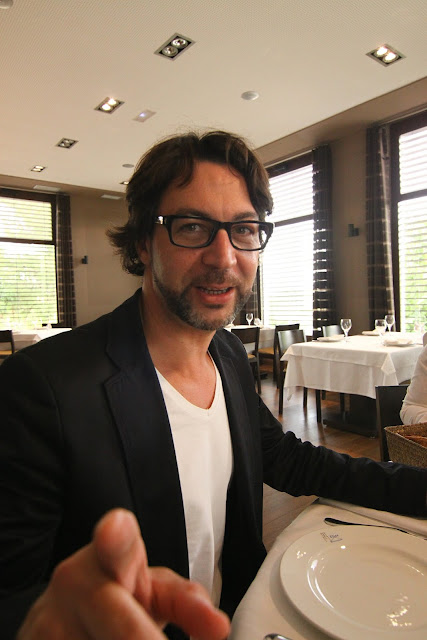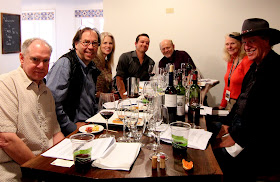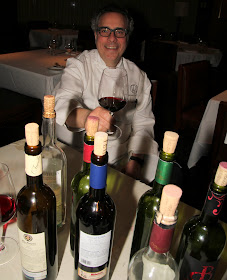* * * * *

Santi Santamaria
Photo: Gerry Dawes©2012 / gerrydawes@aol.com /
http://thespanishartisanwinegroup.com / http://gerrydawesspain.com
* * * * *
Sadly, three-star Catalan chef Santi Santamaría and two other Catalan friends of mine, Pinotxo's Albert Asín and Boquería Owner’s Association President Manel Ripol all died around this time in 2011. I still miss all of them very much. Hard to believe that they have been gone for five years.
The late Manel Ripoll, then President of
La Boquería market in Barcelona.
Photo: Gerry Dawes©2012 / gerrydawes@aol.com
The late Albert Asín Bayen, who, with his brother Jordi,
manned the stoves at Pinotxo in La Boquería, Barcelona.
Photo: Gerry Dawes©2012 / gerrydawes@aol.com
manned the stoves at Pinotxo in La Boquería, Barcelona.
Photo: Gerry Dawes©2012 / gerrydawes@aol.com
This is from my article in Food Arts about Santi Santamaría sudden death on Feb. 16, 2011.
(Short slide show at the end of the article.)
Seven-star Catalan Chef Santiago “Santi” Santamaría
Dies in Singapore
by Gerry Dawes
We all must die, but few of us will go out in such a blaze of glory as Santiago “Santi” Santamaría, one of Europe’s greatest chefs, who died in Singapore of a massive heart attack on February 16. The night before he died, the 53-year old Santi was at an event with fellow celebrity chefs Wolfgang Puck, Mario Batali, Tetsuya Wakuda, Daniel Boulud, Guy Savoy and Justin Quek, all of whom were in Singapore to promote their restaurants in the newly opened Marina Bay Sands complex. According to one of the multitude of journalists from around the world who were invited to cover this heavily promoted event, Cristino Álvarez, a veteran Spanish food journalist, “Later, Santi joined me two other top Spanish food writers, Carlos Maribona and Juanma Bellever, for gin-and-tonics (the de rigor drink of Spanish chefs).”
The next day each of the star chefs served samples of their food to groups of the invited journalists. Santamaría’s dishes included the traditional pan tumaca, Catalan bread spread with a combination of Spanish extra virgen olive oil and raw garlic, rubbed with fresh tomato and topped with paper-thin slice of Ibérico ham. According to Cristino Álvarez, Santamaría was in the dining room and asked him if he would like to see the kitchen. Santamaría whose corpulent figure was more than ample evidence of his well-documented love of eating, had just finished eating a piece of pan tumaca. Ironically this quintessentially Catalan dish would be the last morsel of food ever savored by Santamaría–a traditionalist from inland, mountainous Montseny region of Catalunya--whose modern dishes were always designed to incorporate his insistence on Catalan roots, even though the techniques and twists he put on the dishes were often unmistakably French, influenced his the large collection of cookery books from France.
Álvarez told this writer, “As we entered the kitchen, Santi turned to me and said, ‘I am really going downhill fast!’ and then he collapsed. I summoned help and several of us futilely tried to revive him.”
Álvarez told this writer, “As we entered the kitchen, Santi turned to me and said, ‘I am really going downhill fast!’ and then he collapsed. I summoned help and several of us futilely tried to revive him.”
The self-taught Santamaría was an exceptionally talented, albeit exceptionally controversial chef. His flagship establishment at the time of his death is El Racó de Can Fabes, in the village of San Celoni (near Barcelona). Santamaría, who like his father and grandfather was born in the house that became his restaurant, then hotel. He left his studies as an industrial engineer, opened a bar, then a Catalan bistro here, serving such dishes as pan amb tomaquet (the tomato bread, his last bite), botifarra amb mongetes (beans with Catalan sausage), before El Racó de Can Fabes, with Santamaría manning the kitchen, evolved into the first Catalan restaurant to earn three Michelin rosettes (in 1994; his first came in 1989). He went on to open successful restaurants in Barcelona and Madrid through his association with Hesperia hotel group.
Santamaría’s feuds with Spain’s cocina de vanguardia chefs, especially Ferran Adriá, over their use of commercial food industry enhancements to their food made headlines in Europe and turned Santamaria into a pariah among his Spanish peers and Spain’s gastronomy writers.
In spite of the ostracism, he earned a total of seven Michelin rosettes (the most held by any chef from Spain), including two for his San Celoni restaurant in Madrid and he also opened restaurants in Asia at Dubai’s Atlantis Hotel and in Singapore the eponymous Santi, run by his daughter, Regina, who was with him when he died. Santamaria also wrote 10 books on cooking and was awarded Spain's National Gastronomy Prize in 2009.
After Daniel Boulud returned to New York, he told me, “Santi was in great spirits the night before he died, so his death was a great shock to all of the chefs. The gala dinner, when all the chefs at the Marina Bay complex were supposed to cook, was the night after Santi died. We all decided to dedicate the dinner to him, so we put our very best efforts in our dishes to pay homage to Santi. Afterwards we got together, Mario Batali made some food and we all reminisced about him. He was such a truly great chef.”
Fellow three-star chef, Guy Savoy said “Santi left us for too early, but to take leave of us in his kitchen was a beautiful way to go."
--The End--
* * * * *
Gerry Dawes's Persistence of Memory* (Salvador Dalí) Melting Watch Awards.
To all three of these sadly missed great culinary lights._________________________________________________________
Gerry Dawes was awarded Spain's prestigious Premio Nacional de Gastronomía (National Gastronomy Award) in 2003. He writes and speaks frequently on Spanish wine and gastronomy and leads gastronomy, wine and cultural tours to Spain. He was a finalist for the 2001 James Beard Foundation's Journalism Award for Best Magazine Writing on Wine, won The Cava Institute's First Prize for Journalism for his article on cava in 2004, was awarded the CineGourLand “Cinéfilos y Gourmets” (Cinephiles & Gourmets) prize in 2009 in Getxo (Vizcaya) and received the 2009 Association of Food Journalists Second Prize for Best Food Feature in a Magazine for his Food Arts article, a retrospective piece about Catalan star chef, Ferran Adrià.
". . .That we were the first to introduce American readers to Ferran Adrià in 1997 and have ever since continued to bring you a blow-by-blow narrative of Spain's riveting ferment is chiefly due to our Spanish correspondent, Gerry "Mr. Spain" Dawes, the messianic wine and food journalist raised in Southern Illinois and possessor of a self-accumulated doctorate in the Spanish table. Gerry once again brings us up to the very minute. . ." - - Michael & Ariane Batterberry, Editor-in-Chief/Publisher and Founding Editor/Publisher, Food Arts.
Trailer for a proposed reality television series on
wine, gastronomy, culture and travel in Spain.
wine, gastronomy, culture and travel in Spain.
Web Pages:
Gerry Dawes's Spain: An Insider's Guide to Spanish Food, Wine, Culture and Travel
Adventures in Spanish Taste: Insider's Food, Wine, Cultural and Photographic Travel in Spain
The Traveling Gastronomer: A Celebration of Food, Wine, Life, Photography & Quixotic Musings
The Spanish Artisan Wine Group-Gerry Dawes Selections
Gerry Dawes's Spain: An Insider's Guide to Spanish Food, Wine, Culture and Travel
Adventures in Spanish Taste: Insider's Food, Wine, Cultural and Photographic Travel in Spain
The Traveling Gastronomer: A Celebration of Food, Wine, Life, Photography & Quixotic Musings
The Spanish Artisan Wine Group-Gerry Dawes Selections
Gallery of Chefs & Food Personalities: Portraits by Gerry Dawes
Gerry Dawes can be reached at gerrydawes@aol.com.
Gerry Dawes can be reached at gerrydawes@aol.com.









